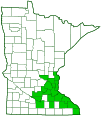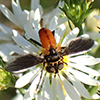swift feather-legged fly
(Trichopoda pennipes)
Conservation • Description • Habitat • Ecology • Distribution • Taxonomy
Conservation Status |
|
|||||||
| IUCN Red List | not listed |
|||||||
| NatureServe | not listed |
|||||||
| Minnesota | not listed |
|||||||
Description |
||
Swift feather-legged fly is a medium-sized tachinid fly. It is native to western Europe and North America. In the United States it is common east of the Great Plains, was introduced and is locally common on the west coast, and is present but uncommon in the arid southwest. It was introduced in California as a biological agent to control the squash bug, an agricultural pest. It is relatively common in the southeast quarter of Minnesota, where it is at the northern extent of its range. Adults are ¼″ to ½″ long, about the size of a house fly. The head is black and velvety. There are two large compound eyes at the side of the head and three small simple eyes (ocelli) in a triangle at the top of the head. The compound eyes are brown. They do not meet at the top of the head in either sex. The upper face (frons), corresponding to the forehead, is black. The area between the frons and the compound eye (frontorbital plate) is yellow. The antennae have three segments. The second segment has a longitudinal groove (suture) on top. The third segment has a long, forward-pointed bristle (arista) on the upper side. The arista is bare, not feather-like (plumose). The protruding mouthpart (proboscis) is not slender and piercing. The thorax has three segments. Each segment has four principal exoskeletal plates, one above, one below, and one on each side. The upper (dorsal) plates, from front to rear, are the prescutum, scutum, and scutellum. There is a distinct groove (transverse suture) across the thorax separating the prescutum and scutum. The prescutum is light orange with three broad black stripes that do not quite reach the suture. The scutum is entirely black, sometimes with two faint orange stripes. The scutellum is black. The plate on each side just above the base of the hind leg (hypopleuron) has a row of bristles. The part of the thorax from which the wings arise (pteropleuron) also has bristles. The abdomen is bright orange, often with a blackish smudge. On the female, the tip of the abdomen is entirely black. On the male it is entirely orange. As with all flies, there is only one pair of wings, the hind wings being reduced to small, knob-like structures (halteres) that are used for balance in flight. The halteres are yellow. The wings on the female are entirely smoky brown and mostly opaque, becoming transparent at the rear margin. On the male there is often orange on the basal half at the forward (costal) margin. At the base of each wing there are two small, rounded lobes (calypters) that cover the halteres. The calypters are well-developed and bright orange. The first posterior cell (R5) is narrowed at the wing tip The legs are mostly black except for the first segment (coxa) and the base of the third segment (femur) of each leg, which are orange. The fourth segment (tibia) of the hind leg is robust and bears a prominent, feather-like fringe of long, black, flattened hairs. |
||
Size |
||
Total length: ¼″ to ½″ |
||
Similar Species |
||
Habitat |
||
|
||
Ecology |
||
Season |
||
|
||
Behavior |
||
|
||
Life Cycle |
||
The female lays one or more eggs usually on the underside of a host insect. When the eggs hatch the larvae bore into the insect body. Only one larvae per host survives. After two weeks the larvae, which has grown to about the size of the host’s body, emerges, killing the host. The larva (maggot) burrows into the soil, pupates, and emerges as an adult in about two weeks. There are up to three generations per year. The last generation overwinters in the soil as pupae, or in the body of the host. |
||
Larva Food |
||
Leatherbugs (Coreoidea), stink bugs (Pentatomidae), shield-backed bugs (Scutelleridae), and bordered plant bugs (Largidae) |
||
Adult Food |
||
Flower nectar |
||
Distribution |
||||
|
Sources |
|||
| 10/5/2023 | ||||
Occurrence |
||||
Relatively common in southeast Minnesota |
||||
Taxonomy |
|||
Order |
Diptera (Flies) | ||
Suborder |
Brachycera | ||
| Infraorder | Cyclorrhapha | ||
| Zoosection | Schizophora | ||
| Zoosubsection | Calyptratae (Calyptrate Flies) | ||
Superfamily |
Oestroidea (Bot Flies, Blow Flies, and Allies) | ||
Family |
Tachinidae (Tachinid Flies) | ||
Subfamily |
Phasiinae | ||
Tribe |
Gymnosomatini | ||
Genus |
Trichopoda (feather-legged flies) | ||
| Subgenus | Galactomyia | ||
Synonyms |
|||
Musca pennipes Phasia jugatoria Thereva hirtipes Thereva pennipes Trichopoda cilipes Trichopoda flavicornis |
|||
Common Names |
|||
swift feather-legged fly |
|||
Glossary
Arista
A large bristle on the upper side of the third segment of the antenna of a fly. Plural: aristae.
Calypter
On flies: one of two small membranous lobes at the base of the forewing that covers the haltere.
Costal margin
The leading edge of the forewing of insects.
Halteres
In flies: a pair of knob-like structures on the thorax representing hind wings that are used for balance.
Ocellus
Simple eye; an eye with a single lens. Plural: ocelli.
Proboscis
The tube-like protruding mouthpart(s) of a sucking insect.
Scutellum
The exoskeletal plate covering the rearward (posterior) part of the middle segment of the thorax in some insects. In Coleoptera, Hemiptera, and Homoptera, the dorsal, often triangular plate behind the pronotum and between the bases of the front wings. In Diptera, the exoskeletal plate between the abdomen and the thorax.
Tibia
The fourth segment of an insect leg, after the femur and before the tarsus (foot). The fifth segment of a spider leg or palp. Plural: tibiae.
Visitor Photos |
|||||
Share your photo of this insect. |
|||||
| This button not working for you? Simply email us at info@MinnesotaSeasons.com. Attach one or more photos and, if you like, a caption. |
|||||
Babette Kis |
|||||
Trichopoda pennipes Swift feather-legged fly Trichopoda pennipes, swift feather-legged fly, on white aster flowers. Photos were taken on October 2, 2023 at Barnes Prairie, Racine Co., WI. Temperature about 78F, windy, sunny, late afternoon. There were several of these flies on white aster flowers. They've been prevalent here this year, along with a number of stinkbugs, which are one of their larval hosts. |
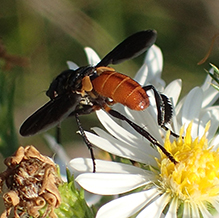 |
||||
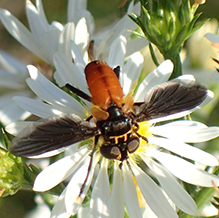 |
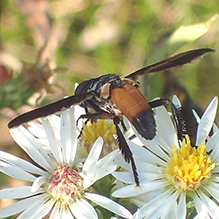 |
||||
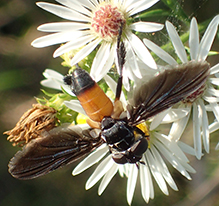 |
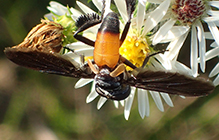 |
||||
Alfredo Colon |
|||||
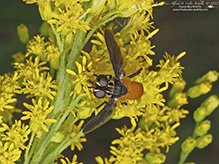 |
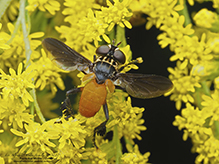 |
||||
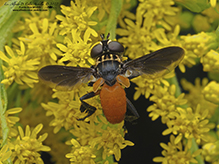 |
|||||
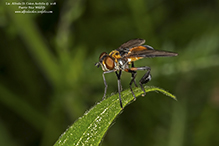 |
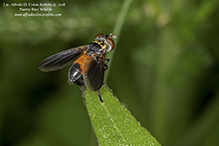 |
||||
 |
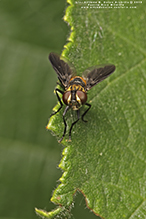 |
||||
Mike Poeppe |
|||||
… in the yard just west of Houston, MN. |
|||||
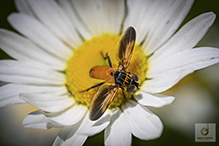 |
|||||
MinnesotaSeasons.com Photos |
|||||
|
|||||

Slideshows |
||

Visitor Videos |
|||
Share your video of this insect. |
|||
| This button not working for you? Simply email us at info@MinnesotaSeasons.com. Attach a video, a YouTube link, or a cloud storage link. |
|||
Other Videos |
|||
| Trichopoda pennipes = FEATHER-LEGGED TACHINID FLY Rob Curtis |
|||
About
Published on Oct 25, 2016 Trichopoda pennipes = FEATHER-LEGGED TACHINID FLY |
|||
| Trichopoda pennipes Rui Andrade |
|||
About
Published on Aug 7, 2010 04/08/2010 - Portugal |
|||


Created: 2/9/2019
Last Updated:
